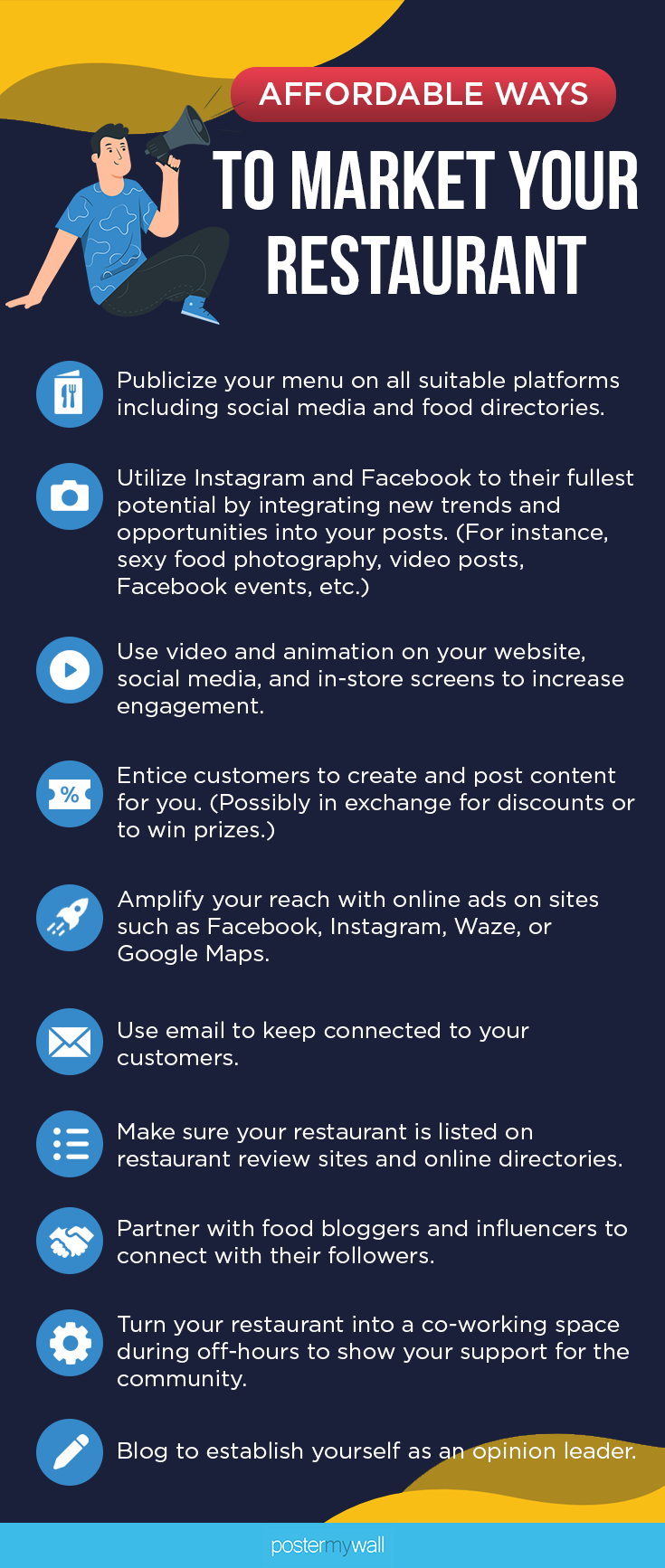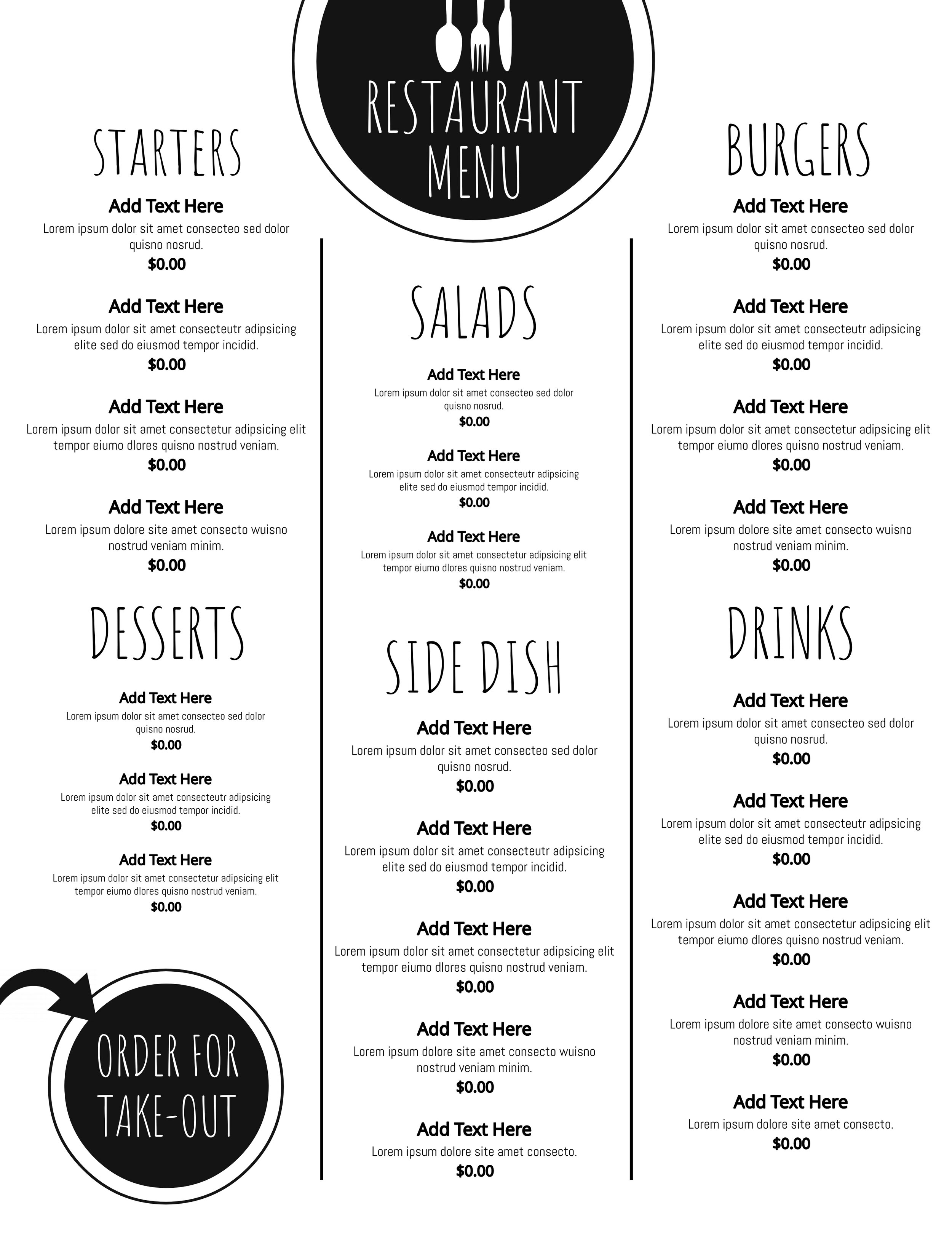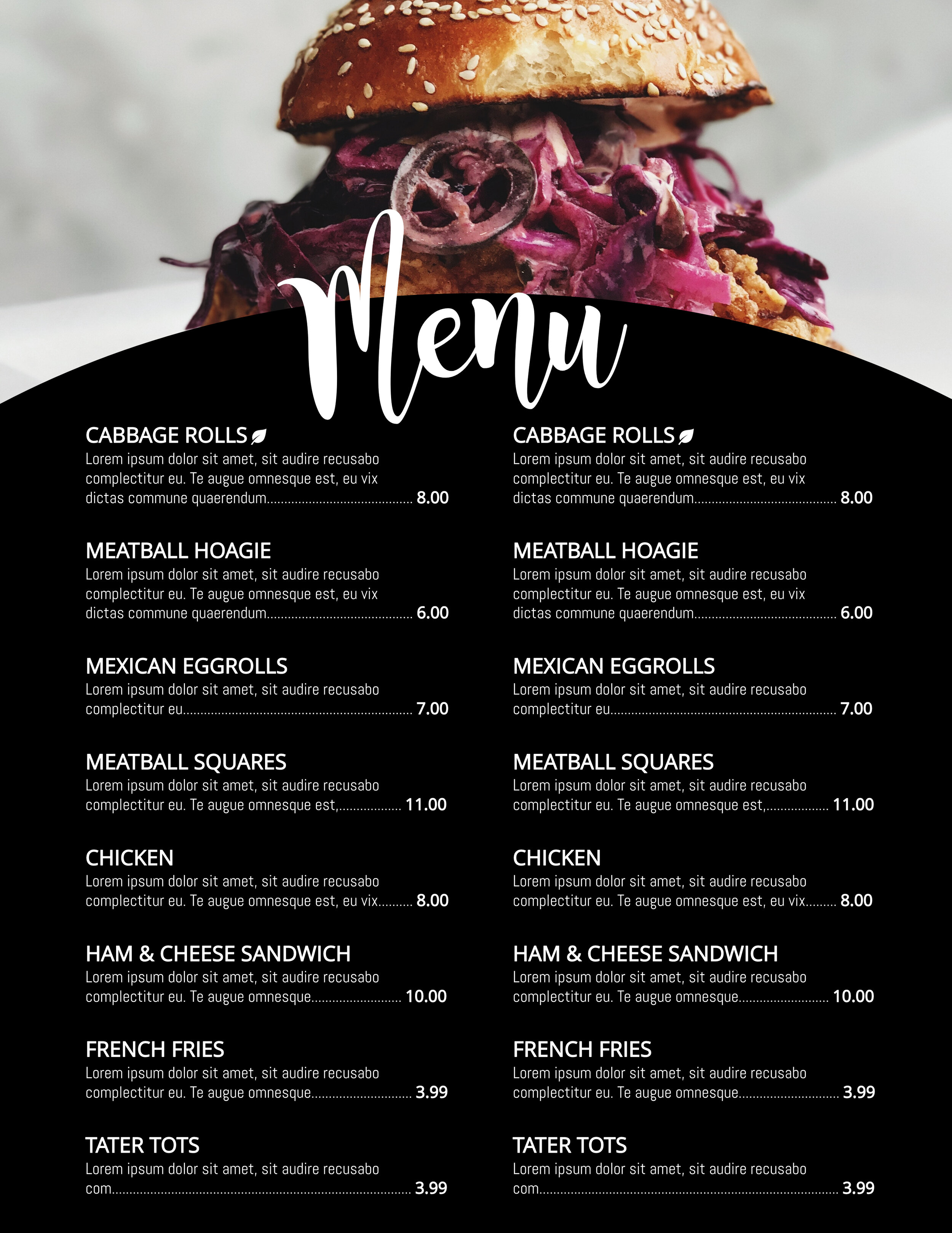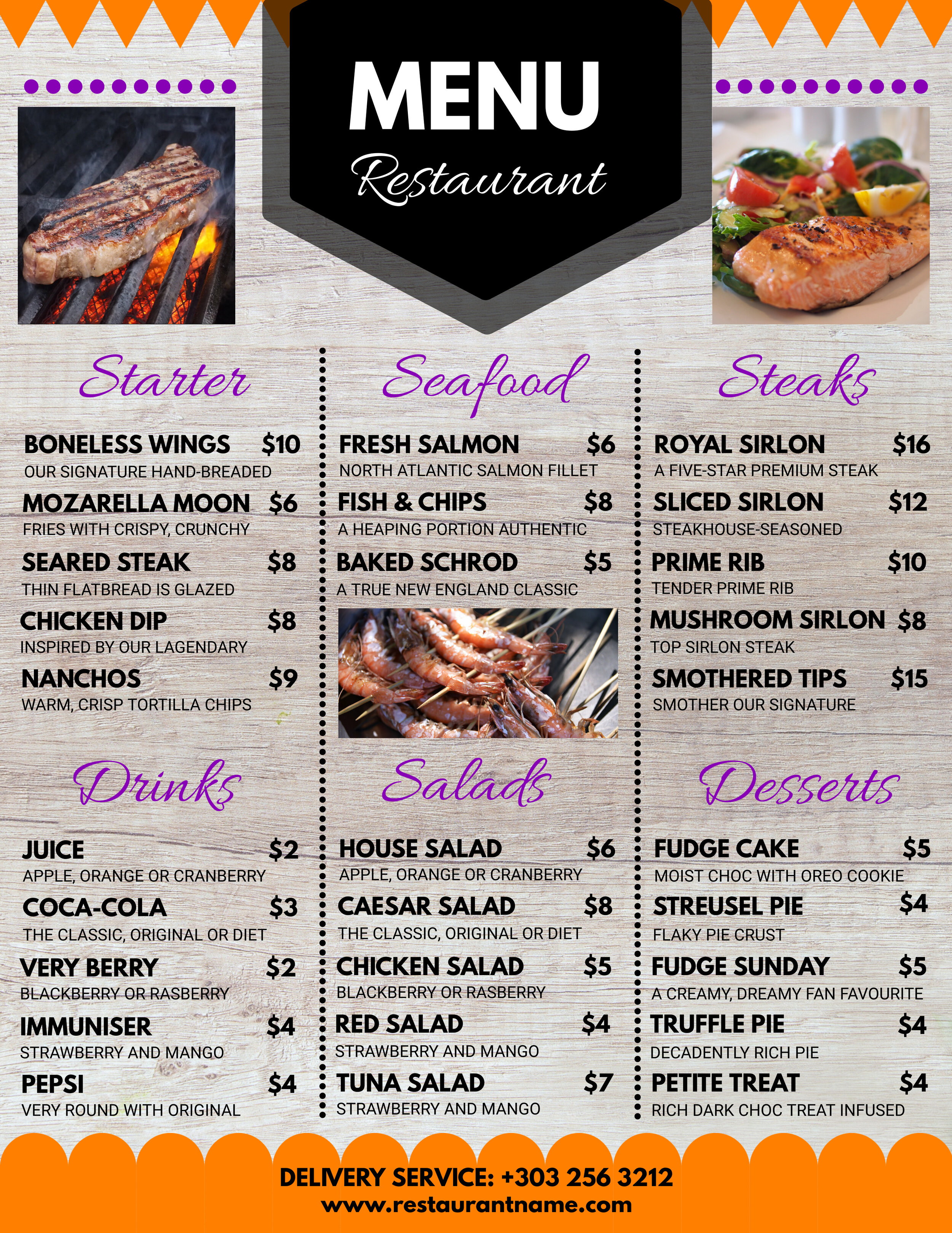The Basics of Restaurant Marketing
Competition between restaurants remains fierce as establishments recreate themselves with outdoor, takeout, and food delivery options.
With everything changing so quickly, it is advisable to revisit and revise your marketing techniques frequently to ensure you’re making the most of current opportunities.
In order to help, PosterMyWall has created a list of the easiest and most affordable ways to market your restaurant. Here’s a quick summary. Save the image below and return to it whenever you need a quick recap!
Publicize Your Menu
Your menu is more than a list of food items--it’s also an opportunity to influence what visitors order--and to increase how much they spend at your restaurant.
Maximize your menu’s impact by designing it to reflect your restaurant’s brand image. Make your menus fun to look at and use your design to visually highlight your highest margin items. (For instance by surrounding those items with additional white space or by placing their descriptions inside a decorative border.)
Select fonts that reflect the ambiance or feel of your dining room and make sure the text is easy to read. Include images, if they enhance your brand image and entice people to visit. Just don’t overdo it by adding too many items--an overcrowded menu becomes hard. And worse, it could detract from your brand image.
While you design your menu, remember that it has a life beyond the tables in your restaurant. Consider how it will look in person, printed in a takeaway version, and posted online. You might even want to design separate versions of your menu for each application.
Once your restaurant has created a stunning, mouthwatering menu, display it on all of the social media platforms that your restaurant is active on so that the people who visit your social media pages will be enticed to come in.
One way to keep people interested in coming back--and to attract new customers--is by updating your menu with seasonal items. You might also keep things fresh by creating themed menus for different seasons or holidays. For instance, replace your warm winter dishes with cooler, lighter items in the summer. As you add new/seasonal items to your menu, announce and promote them through posts on your social media platforms. Upload your updated and special menus to multiple online food directories as well--you never know how or where customers are going to find you. Plus, more inbound links will improve your SEO ranking.
Social Media
Many restaurants find Instagram posts are a great way to engage with their customers. People love looking at mouth-watering photos of food and cocktails, as well as at photos of other customers having a good time--so creating this sort of content for your page is an easy place to start. Just make sure the quality and aesthetic of your images matches your brand. Your food images have to look appetizing and your photos need to maintain a consistent visual style that is as casual--or upscale----as your establishment.
72% of people searching for a restaurant to eat at use Facebook, which remains the largest social media platform in the world. Your business can capitalize on Facebook’s huge audience by maintaining an attractive Facebook business page.
A strong Facebook presence starts with a compelling brand image on your page’s header. Once you’re happy with your page’s appearance, you can invite people to follow you--both online and in person when they come to your restaurant. Popular post content includes eye-catching visuals of your food, logo, and restaurant. You can also use posts to publicize your specials, and share your news. Boost your best posts to reach more people. Even just $5.00 or $10.00 can make a big difference.
Facebook Events are a great way to drive attendance to both in-person and online events. They’re easy to set up--just follow these directions. Facebook will allow you to invite guests, share posts about your event, add a cover photo or video, and edit your event details. The people you have invited can respond by marking themselves “going” or “interested”. Facebook will then automatically send them a reminder about the event.
You can also build anticipation by updating your page with posts that tease your event and provide more details. If you’d like to create a sense of urgency, limit the number of tickets available, set an RSVP cut-off date, or offer an early-bird special.
Video and Animation
Video and animation are great tools for getting your restaurant noticed on social media. They work because motion attracts attention and enhances the viewer’s experience. Video and animation also help to make your ad or post stand out from the rest of your audience’s feed.
You can even kick your promotion up a notch by adding sound.
Here’s an example: Imagine a photo of a sizzling steak. Yummy, right? Now imagine a video of a steak on the grill. As the flames gently lick the meat, you see the juices drip. Steam rises and you hear a tantalizing sizzle. See how tantalizing that can be?
If you don’t have video available, consider adding impact to your images with motion. This could be intro animation where the image slides into place, animated text that tells your story one word (or line) at a time, or adding a GIF.
How might you use video or animation? Options include:
Promote your menu and highlight your standout dishes.
Showcase your restaurant’s interior or the neighborhood where you are located to attract visitors.
Give customers a preview of what the experience of eating at your restaurant is going to feel like.
Show what your customer experience is like so other prospective customers will want to participate in that experience too.
Profile your staff to show how much they care about taking care of your customers.
Interview your suppliers to show where your fresh ingredients come from.
Streaming
Another option is to stream live onto Facebook or Instagram. According to Facebook, the average person spends 3-times longer watching a live video than they will watching one that has been pre-recorded. And streaming live can be a lot of fun for you as you share an event or give your audience a sneak peek at your restaurant.
What might you stream? Some ideas:
Showcase your chef cooking up her newest creation. Think of it as your restaurant’s own, personal cooking show. Like the Food Network only better, because after people watch the dish being created, they can come to the restaurant and try the dish.
Share events hosted by your restaurant such as your trivia night, holiday festivities, or other seasonal activities.
Stream the delivery of fresh ingredients.
Reveal your daily or weekly specials.
Customer-Generated content
When it comes to selecting where to eat, many people rely on recommendations from other diners. That’s why social proof in the form of enthusiastic customer visit reports, testimonials, and reviews can provide more benefit than all your other marketing efforts combined.
Take advantage of this opportunity by encouraging people to post about their experience at your restaurant on their social media pages. Although it’s best if this happens somewhat organically, you might offer vouchers, discount codes, or a free drink/dessert to thank customers for “checking in” at your restaurant on social media--or leaving a review on your Facebook page.
Social Media Advertising
Facebook and Instagram ads are relatively affordable options to extend your reach on social media beyond your existing followers. You can also try running an ad on Waze, Google Maps, and other navigation apps.
If you’re just getting started with online advertising, it’s best to start small. Allocate a small budget and try an experiment. Then review your ROI, adjust your approach, and move forward cautiously from there. Some restaurants crack the code to success, while others never see a positive return on their investment. So you have to decide what works best for you.
The key components of designing these ads are selecting the right message, targeting the audience correctly, and choosing the right offer. For instance, some restaurants find that discount coupons or buy-one-get-one-free offers will drive traffic. Others find that enticements have a negligible impact. It often pays to try A/B testing where you run two nearly-identical campaigns at once to see which performs best. The slight difference between the campaigns could be the time of day when the ads are run, the graphic image that supports the ad, the headline, the offer, or what specific audience segment is targeted.
Email Marketing
Email marketing is effective, cost-friendly, and can be personalized with your customer’s name. Use email to entice people to visit, invite them to a special event, inform them of a menu update, extend a special offer, or to notify them about a promotion or giveaway.
You can also turn your emails into newsletters by sharing your philosophy on food and hospitality, sharing recipes for your customers to make at home, or updating them with your latest news.
The reason emails are incredibly effective is that your audience has actively subscribed--meaning they’ve agreed to receive your marketing. The difficult part is to grow your subscriber list. This takes time and ongoing effort.
The current best practice in building a subscriber list is to offer something your audience will value as a thank you for subscribing. Although this could be a coupon for a discount or a free item, you’ll build a higher quality list if you share something not available anywhere else that enables your subscribers to self-qualify as true fans. For instance, you might offer a behind-the-scenes video tour of your kitchen or the recipe for one of your most popular dishes. The trick to selecting the right enticement is to know what your customer will appreciate--and then deliver.
As we noted earlier, inviting people to subscribe to your email list is an ongoing process. Tactics include a sign-up link on your website, invitations issued via social media, and direct invitations to anyone who visits your shop or orders online. Once you have a list, you can use PosterMyWall’s email capability to send your communication.
Food Directories and Listing Sites
Before selecting a restaurant, people often check online listing sites that include reviews. These include Yelp, Zomato (formerly Urbanspoon), Local, Open Table, and, of course, Facebook. Ensure that these customers find what they need by making your listings on all of these sites comprehensive. Include maps to your locations, a current menu, contact information, reviews, posts, photos and videos, reservation widgets, and anything else that helps answer customer’s questions. And keep your library of positive coverage growing by inviting happy customers to post new reviews to these sites.
Some tips:
Yelp can also be linked with Opentable, the most recognized online restaurant reservation site in the United States, as well as with external food delivery services such as Seamless or Delivery. Your restaurant’s position on Yelp is based on the number of reviews, whether or not you’ve purchased a paid sponsored placement, and various category attributes.
If you pay a fee, Yelp will “feature” your venue. This means that when a user conducts a search that your restaurant fits, you are more likely to appear within the first two pages of results. Also, if you pay for your placement, Yelp will make your restaurant more visible when customers search through Google. This form of premium paid advertising is especially useful when marketing a new restaurant.
Restaurants who base their marketing on location targeting and last minute decision making can utilize Foursquare, an app that provides personalized recommendations of places to go near a user's current location based on users' previous browsing and check-in histories.
Zomato is another popular review site.
Local is another search site that posts reviews.
Nextdoor is a super-local local search site that posts restaurant recommendations.
In addition to websites that feature reviews, there are other sites that are directories only. Maintaining a current listing on these sites benefits you in several ways. First, the more places you are listed, the more likely you are to be found by new customers. Second, these listings include a link to your website--which means additional backlinks to your website. Backlinks elevate your SEO ranking, so the more good quality, do-follow external links you have, the higher your chances are of being shown near the top of Google searches for relevant keywords.
Restaurant directory sites include:
Grubhub. Listing on Grubhub is free. However, there is a fee to use the service to take orders. GrubHub listings feed over to other sites like MenuPages and Seamless.
Zagat. Zagat focuses on more upscale dining and accepts listings by application only. If they accept you, the listing is free.
Other sites you might want to list or advertise on include:
Food Bloggers/Influencers
Food bloggers have become an integral part of the social media landscape for restaurants. There are over 227 million food bloggers in the U.S. alone. A positive mention from a food blogger might get you in front of dozens--or even hundreds--of potential customers--so it is well worth the effort to build relationships with these super-influencers.
A few Google searches will reveal who the most-followed food bloggers in your area are. Or sign up for an influencer marketing platform to find influencers who might be amenable to promoting your restaurant.
Once you’ve identified the influencers you want, reach out, Invite them to your restaurant, build rapport, serve your best dishes--and then let them take it from there.
Another way to build rapport with your community is to, when it’s safe, welcome people who work from cafes, coffee shops, and diners to use your space between your meal-time rushes. You can even turn your dining room into co-working space during off-hours using apps like Spacious, Reset, and WorkChew.
Start Your Own Blog
A well-executed blog can elevate your restaurant’s stature by establishing you as an opinion leader in the food industry. Plus, by adding new, high quality content to your website on a regular basis, you’ll boost your SEO ranking.
So what might you blog about? Whatever you’re passionate about because, having that passion come through in your posts is what will attract an audience. For instance, you might:
Share unique recipes that underscore your unique style of cooking.
Identify and comment on restaurant marketing trends so that up and coming food entrepreneurs look to you as the voice of authority.
Highlight your favorite ingredients and how to use them.
Demonstrate food plating and presentation techniques that elevate the look of your customers’ tables at home.
By changing up your marketing plan even a few of these strategies, you’ll notice an increase in ROI, brand awareness and most importantly, an influx of customers who will come back for more.













